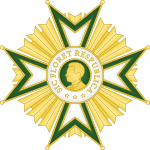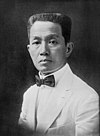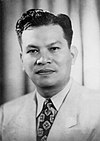
The Commonwealth of the Philippines was an unincorporated territory and commonwealth of the United States that existed from 1935 to 1946. It was established following the Tydings–McDuffie Act to replace the Insular Government of the Philippine Islands and was designed as a transitional administration in preparation for full Philippine independence. Its foreign affairs remained managed by the United States.
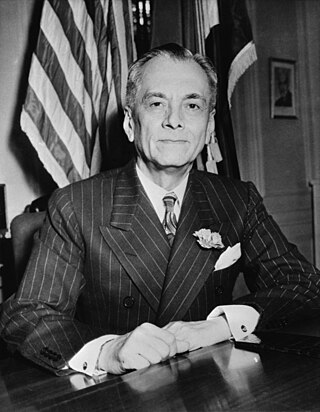
Manuel Luis Quezon y Molina, also known by his initials MLQ, was a Filipino lawyer, statesman, soldier, and politician who was president of the Commonwealth of the Philippines from 1935 until his death in 1944. He was the first Filipino to head a government of the entire Philippines and is considered the second president of the Philippines after Emilio Aguinaldo (1899–1901), whom Quezon defeated in the 1935 presidential election.

The president of the Philippines is the head of state, head of government and chief executive of the Philippines. The president leads the executive branch of the Philippine government and is the commander-in-chief of the Armed Forces of the Philippines.

The Order of National Artists of the Philippines is an order bestowed by the President of the Philippines on Philippine nationals who have made significant contributions to the development of Philippine art. Members of the Order are known as National Artists. Originally instituted as an Award, it was elevated to the status of an order in 2003.

Elpidio Rivera Quirino was a Filipino lawyer and politician who served as the 6th President of the Philippines from 1948 to 1953.

Sergio Osmeña Sr. was a Filipino lawyer and politician who served as the fourth President of the Philippines from 1944 to 1946. He was Vice President under Manuel L. Quezon. Upon Quezon's sudden death in 1944, Osmeña succeeded him at age 65, becoming the oldest person to assume the Philippine presidency until Rodrigo Duterte took office in 2016 at age 71. A founder of the Nacionalista Party, Osmeña was also the first Visayan to become president.

The Order of Sikatuna is the national order of diplomatic merit of the Republic of the Philippines. It is conferred upon individuals who have rendered exceptional and meritorious services to the Republic of the Philippines, upon diplomats, officials and nationals of foreign states who have rendered conspicuous services in fostering, developing and strengthening relations between their country and the Philippines, or upon personnel of the Philippine Department of Foreign Affairs (DFA), both in the Home Office and in the Foreign Service.

The orders and decorations conferred upon civilians and military personnel in the Republic of the Philippines are listed by orders of precedence. Philippine civilian orders and decorations are conferred by the President of the Philippines in his or her capacity as head of state. In certain instances, the conferment of certain orders and decorations requires the concurrence of the Congress of the Philippines, or of certain advisory bodies.

The Philippine Legion of Honor was established by President Manuel Roxas, through Philippine Army Circular No. 60 dated July 3, 1947. The Philippine Legion of Honor was patterned after the Legion of Merit of the United States of America, and was meant to honor both civilians and members of the military, Filipino or foreign. Originally, like the U.S. Legion of Merit, the Philippine Legion of Honor had four classes, known as degrees, with Legionnaire being the basic rank, and Chief Commander being the highest. With the reform of the Philippine system of orders and decorations in 2003, the Philippine Legion of Honor's classes were renamed "ranks" instead of "degrees", and the ranks expanded.

Jorge Bartolomé Vargas y Celis was a Filipino lawyer, diplomat and youth advocate born in Bago, Negros Occidental, Philippines. He graduated valedictorian from Negros Occidental High School in 1909 and obtained a Bachelor of Arts degree in 1911 and a Bachelor of Law degree with honors in 1914, both from the University of the Philippines. He was a founding member of the Philippine Amateur Athletic Federation in 1911 and served in its executive committee in 1918. He served as its second chairman from 1935 to 1955. He was also the first Filipino member of the International Olympic Committee.
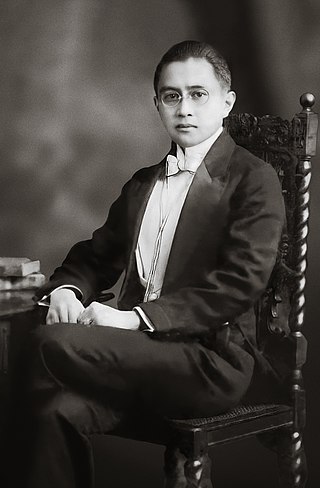
Don Gabriel Amando Daza, KGCR, KC*SS was the first Filipino electrical engineer and one of the charter members of the Boy Scouts of the Philippines (BSP). He co-founded the Philippine Long Distance Telephone Company (PLDT), Philippine Telegraph and Telephone Co. (PT&T), Philippine Electric Manufacturing Company (PEMCO), Phelps Dodge Philippines. He was the supervising engineer and assistant general manager of Visayan Electric Company (VECO) and led its expansion out of Cebu City. President and chief scout of the BSP in 1961–68. In 1945, President Osmeña appointed Daza to be a member of the board of directors of the Manila Railroad Company and the Philippine Charity Sweepstakes Office. In 1950, he was vice-chairman of the National Power Corporation and on the board of directors of the Manila Hotel Company. In 1951, Daza was appointed by President Quirino as a founding member of the board of directors of the National Shipyard and Steel Corporation. President and director of the National Economic Protection Agency (NEPA) in 1956.

The president of the Senate of the Philippines, commonly referred to as the Senate president, is the presiding officer and the highest-ranking official of the Senate of the Philippines, and third highest and most powerful official in the government of the Philippines. They are elected by the entire body to be their leader. The Senate president is second in the line of succession to the presidency, behind only the vice president and ahead of the speaker of the House of Representatives.

The Knights of Rizal is an Order of Chivalry from the Philippines, created to honor and uphold the ideals of Philippine national hero José Rizal.

The Order of Lakandula is one of the highest civilian orders of the Philippines, established on September 19, 2003. It is awarded for political and civic merit and in memory of Lakandula’s dedication to the responsibilities of leadership, prudence, fortitude, courage and resolve in the service of one’s people.

The Order of the Golden Heart is an order of the Philippines.

The Order of Gabriela Silang is an all-female order of the Philippines It is named after Philippine national heroine, Gabriela Silang.
The Presidential Medal of Merit is an honor given by the Republic of the Philippines.
Juan Fuentes Alcazaren was a Filipino Visayan lawyer, legislator, and politician. He was Member of the House of Representatives for the old 4th legislative district of Cebu (1925–1934), Director of Bureau of Lands (1945), and Undersecretary of Department of Foreign Affairs (1958–1959).

The Government of the Commonwealth of the Philippines in exile was a continuation of the government of the Commonwealth of the Philippines after they had been evacuated from the country during World War II. The Commonwealth of the Philippines was self-governing, although under the ultimate control of the United States.
The House of Representatives of the Philippines has three awards they confer to individuals; namely the Congressional Medal of Achievement (CMA), the Congressional Medal of Distinction (CMD), and the Congressional Medal of Excellence (CME).
